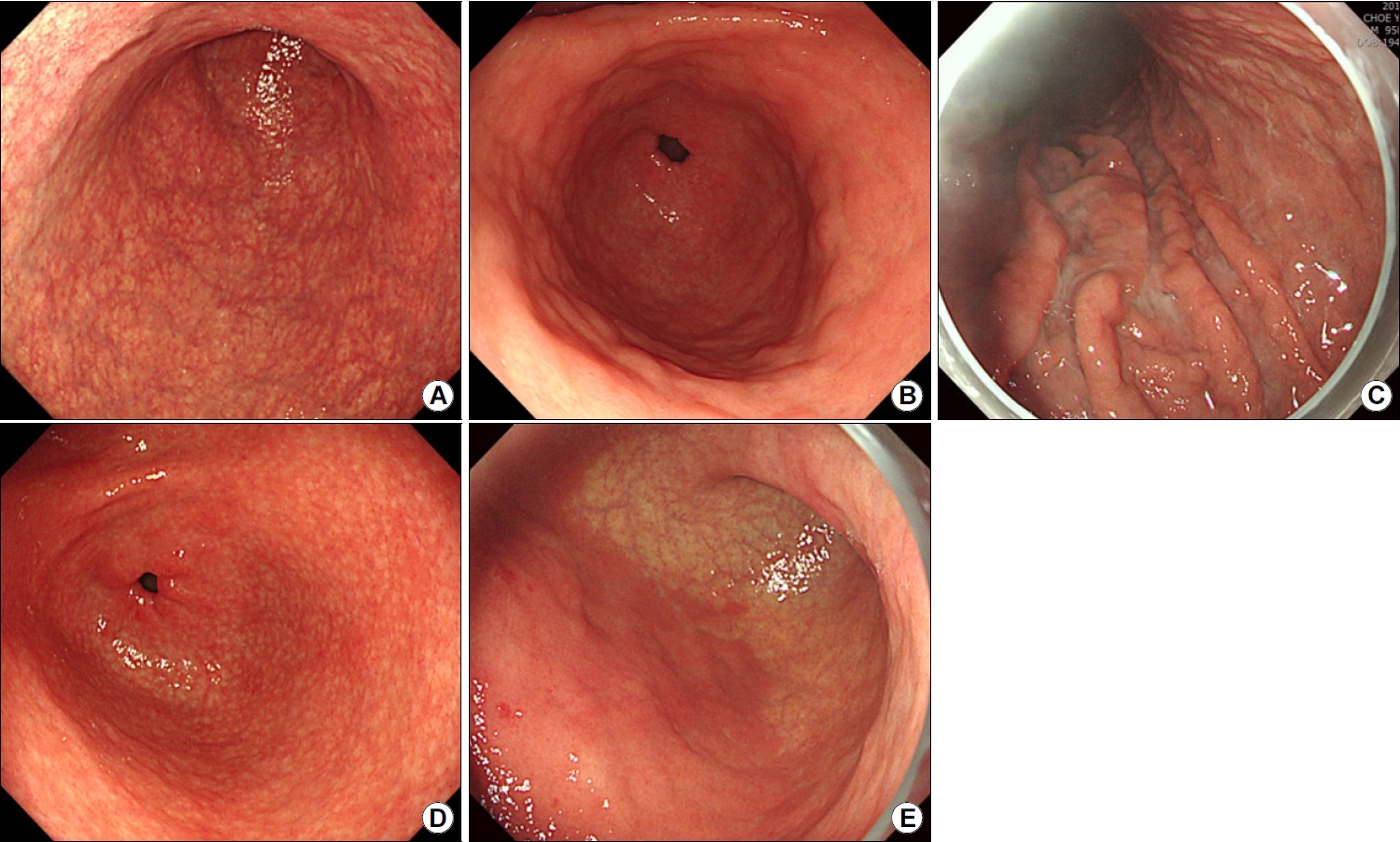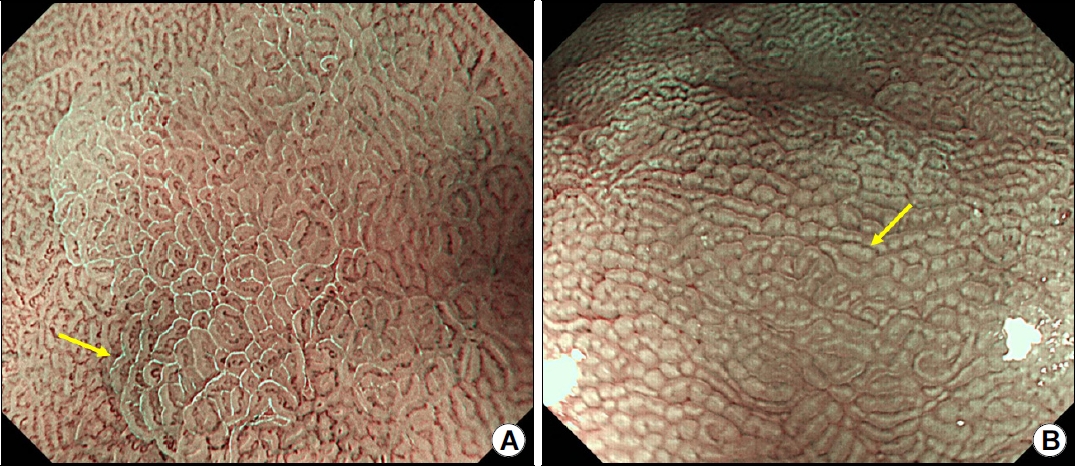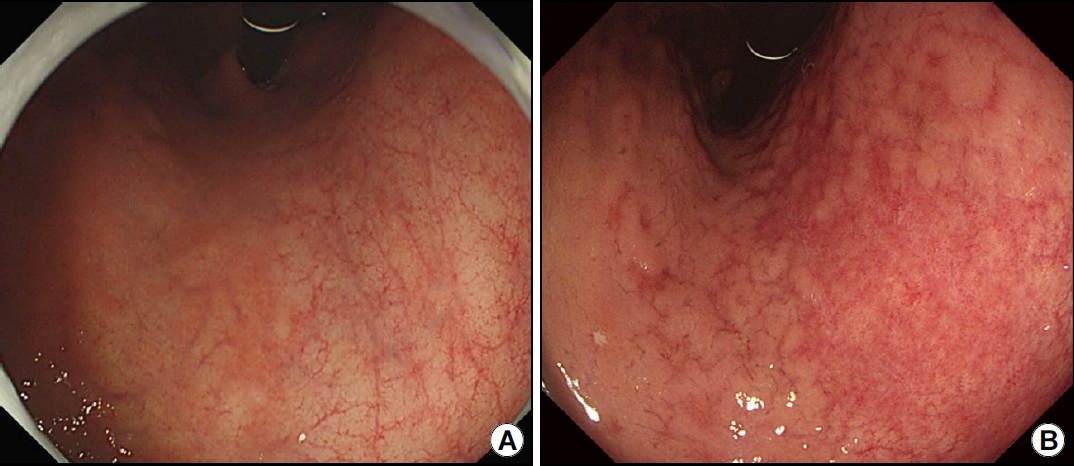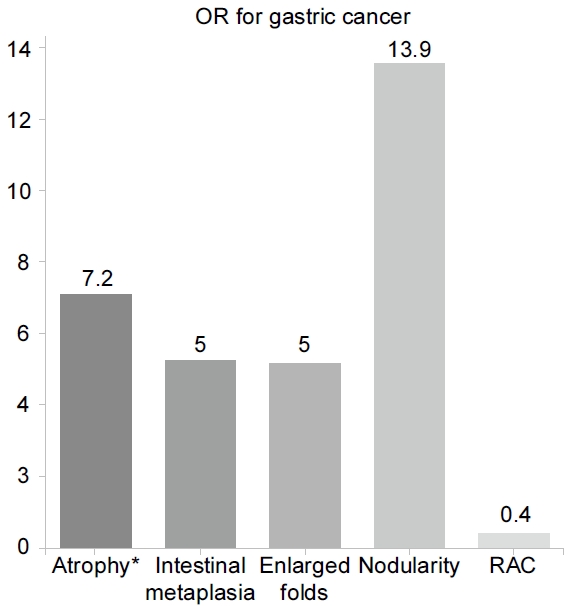3. Joo DC, Kim GH. Endoscopic diagnosis of early gastric cancer. J Korean Med Assoc 2022;65:267–275.


4. Han MA, Oh MG, Choi IJ, et al. Association of family history with cancer recurrence and survival in patients with gastric cancer. J Clin Oncol 2012;30:701–708.


7. Lee YC, Chiang TH, Chou CK, et al. Association between
Helicobacter pylori eradication and gastric cancer incidence: a systematic review and meta-analysis. Gastroenterology 2016;150:1113–1124; e5.


8. Haruma K, Kato M, Inoue K, Murakami M, Kamada T. Kyoto classification of gastritis. Tokyo: Nihon Medical Center, 2017.
9. Kim GH. Endoscopic findings of Kyoto classification of gastritis. Korean J
Helicobacter Up Gastrointest Res 2019;19:88–93.


10. Dixon MF, Genta RM, Yardley JH, Correa P. Classification and grading of gastritis. The updated Sydney system. International workshop on the histopathology of gastritis, Houston 1994. Am J Surg Pathol 1996;20:1161–1181.

11. Kimura K, Takemoto T. An endoscopic recognition of the atrophic border and its significance in chronic gastritis. Endoscopy 1969;3:87–97.

12. Quach DT, Le HM, Nguyen OT, Nguyen TS, Uemura N. The severity of endoscopic gastric atrophy could help to predict operative link on gastritis assessment gastritis stage. J Gastroenterol Hepatol 2011;26:281–285.


15. Fukuta N, Ida K, Kato T, et al. Endoscopic diagnosis of gastric intestinal metaplasia: a prospective multicenter study. Dig Endosc 2013;25:526–534.


16. Chiu PWY, Uedo N, Singh R, et al. An Asian consensus on standards of diagnostic upper endoscopy for neoplasia. Gut 2019;68:186–197.


17. Uedo N, Ishihara R, Iishi H, et al. A new method of diagnosing gastric intestinal metaplasia: narrow-band imaging with magnifying endoscopy. Endoscopy 2006;38:819–824.


19. Kanemitsu T, Yao K, Nagahama T, et al. Extending magnifying NBI diagnosis of intestinal metaplasia in the stomach: the white opaque substance marker. Endoscopy 2017;49:529–535.


22. Kato M. Endoscopic Findings of H. pylori Infection. In: Suzuki H, Warren R, Marshall B, editors. Helicobacter pylori. Tokyo: Springer Japan, 2016. p. 157–167.
23. Murayama Y, Sanomura Y, Miyazaki T, et al. Is
Helicobacter pylori-induced enlarged fold gastritis a high-risk factor for gastric carcinoma? Dig Endosc 2006;18:98–104.

24. Yasunaga Y, Shinomura Y, Kanayama S, et al. Improved fold width and increased acid secretion after eradication of the organism in
Helicobacter pylori associated enlarged fold gastritis. Gut 1994;35:1571–1574.



26. Toyoshima O, Nishizawa T, Sakitani K, et al. Serum anti-
Helicobacter pylori antibody titer and its association with gastric nodularity, atrophy, and age: a cross-sectional study. World J Gastroenterol 2018;24:4061–4068.



27. Uchiyama K, Ida K, Okuda J, et al. Correlations of hemoglobin index (IHb) of gastric mucosa with
Helicobacter pylori (
H. pylori) infection and inflammation of gastric mucosa. Scand J Gastroenterol 2004;39:1054–1060.


28. Sakae H, Iwamuro M, Okamoto Y, et al. Evaluation of the usefulness and convenience of the Kyoto classification of gastritis in the endoscopic diagnosis of the
Helicobacter pylori infection Status. Digestion 2020;101:771–778.



29. Laine L, Cohen H, Sloane R, Marin-Sorensen M, Weinstein WM. Interobserver agreement and predictive value of endoscopic findings for
H. pylori and gastritis in normal volunteers. Gastrointest Endosc 1995;42:420–423.


30. Yagi K, Nakamura A, Sekine A. Characteristic endoscopic and magnified endoscopic findings in the normal stomach without
Helicobacter pylori infection. J Gastroenterol Hepatol 2002;17:39–45.


31. Kato T, Yagi N, Kamada T, et al. Diagnosis of
Helicobacter pylori infection in gastric mucosa by endoscopic features: a multicenter prospective study. Dig Endosc 2013;25:508–518.


33. Yoshii S, Mabe K, Watano K, et al. Validity of endoscopic features for the diagnosis of
Helicobacter pylori infection status based on the Kyoto classification of gastritis. Dig Endosc 2020;32:74–83.



34. Garcés-Durán R, García-Rodríguez A, Córdova H, et al. Association between a regular arrangement of collecting venules and absence of
Helicobacter pylori infection in a European population. Gastrointest Endosc 2019;90:461–466.


36. Otani K, Watanabe T, Kosaka S, et al. Utility of Kyoto classification of gastritis in subjects with a high-negative titer of anti-
Helicobacter pylori antibody during a medical check-up. J Clin Biochem Nutr 2020;67:317–322.



39. Zhao J, Xu S, Gao Y, et al. Accuracy of endoscopic diagnosis of
Helicobacter pylori based on the Kyoto classification of gastritis: a multicenter study. Front Oncol 2020;10:599218.



41. Toyoshima O, Nishizawa T, Arita M, et al.
Helicobacter pylori infection in subjects negative for high titer serum antibody. World J Gastroenterol 2018;24:1419–1428.



43. Toyoshima O, Nishizawa T, Koike K. Endoscopic Kyoto classification of
Helicobacter pylori infection and gastric cancer risk diagnosis. World J Gastroenterol 2020;26:466–477.



44. Itoh T, Kawahira H, Nakashima H, Yata N. Deep learning analyzes
Helicobacter pylori infection by upper gastrointestinal endoscopy images. Endosc Int Open 2018;6:E139–E144.



45. Shichijo S, Nomura S, Aoyama K, et al. Application of convolutional neural networks in the diagnosis of
Helicobacter pylori infection based on endoscopic images. EBioMedicine 2017;25:106–111.



47. Uemura N, Okamoto S, Yamamoto S, et al.
Helicobacter pylori infection and the development of gastric cancer. N Engl J Med 2001;345:784–789.


48. Take S, Mizuno M, Ishiki K, et al. Seventeen-year effects of eradicating
Helicobacter pylori on the prevention of gastric cancer in patients with peptic ulcer; a prospective cohort study. J Gastroenterol 2015;50:638–644.



49. Sakitani K, Hirata Y, Suzuki N, et al. Gastric cancer diagnosed after
Helicobacter pylori eradication in diabetes mellitus patients. BMC Gastroenterol 2015;15:143.



52. Take S, Mizuno M, Ishiki K, et al. The long-term risk of gastric cancer after the successful eradication of
Helicobacter pylori. J Gastroenterol 2011;46:318–324.



53. Shichijo S, Hirata Y, Niikura R, et al. Histologic intestinal metaplasia and endoscopic atrophy are predictors of gastric cancer development after
Helicobacter pylori eradication. Gastrointest Endosc 2016;84:618–624.


57. Chung SJ, Park MJ, Kang SJ, et al. Effect of annual endoscopic screening on clinicopathologic characteristics and treatment modality of gastric cancer in a high-incidence region of Korea. Int J Cancer 2012;131:2376–2384.


59. Nishibayashi H, Kanayama S, Kiyohara T, et al.
Helicobacter pylori-induced enlarged-fold gastritis is associated with increased mutagenicity of gastric juice, increased oxidative DNA damage, and an increased risk of gastric carcinoma. J Gastroenterol Hepatol 2003;18:1384–1391.


61. Miyazaki T, Murayama Y, Shinomura Y, et al. E-cadherin gene promoter hypermethylation in
H. pylori-induced enlarged fold gastritis. Helicobacter 2007;12:523–531.


63. Watanabe M, Kato J, Inoue I, et al. Development of gastric cancer in nonatrophic stomach with highly active inflammation identified by serum levels of pepsinogen and
Helicobacter pylori antibody together with endoscopic rugal hyperplastic gastritis. Int J Cancer 2012;131:2632–2642.


65. Kamada T, Tanaka A, Yamanaka Y, et al. Nodular gastritis with
Helicobacter pylori infection is strongly associated with diffuse-type gastric cancer in young patients. Dig Endosc 2007;19:180–184.

66. Miyamoto M, Haruma K, Yoshihara M, et al. Nodular gastritis in adults is caused by
Helicobacter pylori infection. Dig Dis Sci 2003;48:968–975.

67. Majima A, Dohi O, Takayama S, et al. Linked color imaging identifies important risk factors associated with gastric cancer after successful eradication of
Helicobacter pylori. Gastrointest Endosc 2019;90:763–769.


70. Sakitani K, Nishizawa T, Toyoshima A, et al. Kyoto classification in patients who developed multiple gastric carcinomas after
Helicobacter pylori eradication. World J Gastrointest Endosc 2020;12:276–284.
















